|
Blog Feeds
The SakerIndymedia Ireland is a volunteer-run non-commercial open publishing website for local and international news, opinion & analysis, press releases and events. Its main objective is to enable the public to participate in reporting and analysis of the news and other important events and aspects of our daily lives and thereby give a voice to people.
Public InquiryInterested in maladministration. Estd. 2005
Voltaire NetworkVoltaire, international edition
|
Now it's History (Ireland)! Peter Hart replies on Tom Barry and Kilmichael (but not Dunmanway) national |
history and heritage |
feature national |
history and heritage |
feature
 Friday April 01, 2005 10:47 Friday April 01, 2005 10:47 by Niall Meehan by Niall Meehan
 Hart Ignores Brian Murphy criticism, says Meda Ryan analysis not "rational"
(An introduction to this discussion can be found at this Indymedia article: What Is The Dispute About Kilmichael And Dunmanway Really About? The accusation that the IRA had a sectarian policy during the War of Independence will be addressed in a talk from historian Brian Murphy in Cork on April 15 at 8pm in the Imperial Hotel)
This is unfortunate, not least since Hart insists on a strong relationship between Kilmichael and Dunmanway: one is as important as the other to an understanding of the Cork IRA (1998:292). The killings in Dunmanway were the culmination of a long process of social definition that produced both the heroes of Kilmichael and the victims of the April massacre. (ibid) Hart's eyewitnesses
Peter Hart is circumspect about the sources of his anonymous eyewitness information that no false surrender took place at Kilmichael, confining himself to observing that most of the interviews were conducted by someone else. Three were conducted by the Rev Dr John Chisholm, who admitted in another context to using a free hand in composing recollections of IRA veterans, to visiting a location in order to imagine and then write up an IRA training camp, and to allowing the prevalence of my own style, when editing the memoirs of Liam Deasy (in Ryan 2003: 44, 274-5, 315). Is Hart's an implied admission that the information may not be wholly reliable? Is he distancing himself from it? Even if so, the Chisholm interviewees do not say there was no false surrender; they do not mention the point.
Hart does not address at all the problem that his two anonymous interviewees spoke at a time when records indicate that only one infirm ambush survivor, Ned Young, was still alive (though not at that stage in full control of his faculties). Young died on 13 November 1989. Hart reported that he conducted his final interview, with scout 'AF', on 19 November 1989. I wrote previously (see web link in summary above): "This is an anomaly that needs to be addressed and for which there may be a simple explanation. As of yet, it has not been proffered."
When asked specifically about the criticisms of Meda Ryan and Brian Murphy, Hart asserts that as Murphy's work on British propaganda is not yet published he cannot answer Murphy's criticism. But Murphy's charge that Hart misrepresented the British admission that loyalists in the Bandon area did indeed engage in active informing during the war has been in the public domain since 1999 (see Cherry Picking for more detail). It is contained in a review of Hart's book in The Month, a partial sentence from which is reprinted as a promotional blurb when The IRA and its Enemies was re-printed. In his talk on British propaganda on 15 October last in Dublin Murphy drew attention to Hart's editorship of The Record of the Rebellion, with the title British Intelligence in Ireland 1920-21, the Final Reports (Cork University Press 2002). Hart quoted the Bandon passage in full (see "Cherry Picking) on page 49. Reviewers of Ryan's Tom Barry IRA Freedom Fighter (2003) have remarked on the wealth of evidence that Ryan has unearthed. She removed the lynchpin of Hart's case, that Tom Barry did not mention the false surrender until the publication of his Guerilla Days in Ireland in 1949, that he invented it many years after the battle. The apparent failure to mention it in a major 1932 article by Barry on Kilmichael for the Irish Press was promoted by Hart as a most significant item of evidence. However, Ryan quoted a contemporaneous letter from Barry to the Irish Press criticizing the paper for editing out the reference. False surrender noted in 1921
As Ryan showed, reference to the false surrender first appeared in print in 1921 from a British source, Lloyd George's imperial advisor Lionel Curtis, who wrote: It is alleged by Sinn Fein that a white flag was put up by the police, and that when the attacking party approached to accept the surrender, fire was opened on them. (in Ryan 2003: 56). While also referring to mutilated bodies (a piece of British atrocity propaganda) Curtis expressed himself unsure of the truth of this notorious episode. However, he said the surrender story was obtained from a trustworthy source in the district. (ibid) Piaras Beaslai's life of Michael Collins in 1926 contained: When volunteers advanced to take the surrender, they were fired on. (ibid) Hart asserted that General Crozier, commander of the Auxiliaries at that time (who resigned in protest at the failure to curb Auxiliary atrocities) referred to the false surrender in Ireland Forever, (1932), only because he wished to curry favor with republicans. Hart appears to have missed Barry's reference to the false surrender in a piece he wrote for the Irish defense forces magazine, An Cosantoir, in 1941. Of course, as Hart himself admits, the false surrender story was "circulating within the IRA as early as 1921", (1998:27 fn 21). So why would Barry be required to invent it in 1949?
Psycho Killer
In the interview Hart implies that his reference to Barry as a serial killer was journalistic inference. In fact it was a direct quotation from Hart, given to the Sunday Times (April 19, 1998): "Barry is still considered to be an idealistic figure, unlike the great majority of his comrades he was little more than a serial killer and thought of the revolution largely in terms of shooting people. His politics were very primitive." Hart's outburst is one that Ryan demonstrates to be false, as is Hart's claim that Barry had a record of killing prisoners. There is clear evidence that Barry released combatants after battle, based on whether the particular British regiments they were from did or did not torture and/or execute IRA prisoners. For example, after the Rosscarbery ambush Barry permitted medical treatment for prisoners in the local convent. (Ryan 2003:111) A policy decision was taken to execute members of the notorious Essex Regiment, which exacted brutal treatment on IRA prisoners (commanded by Major AE Percival, who was to gain world renown in 1942 when he surrendered the British garrison in Singapore to a force of Japanese on bicycles).In the interview Hart refers to serial killers on both sides who were not necessarily psychopaths. They were individuals and small groups who did the dirty work. Thus the Dublin squad', commanded by Michael Collins, which wiped out the British intelligence apparatus on Bloody Sunday in November 1920 (one week before the Kilmichael ambush), were hard men who did this dirty work. Barry is consigned to membership of this group of not necessarily but maybe psychopaths. However, Hart's forthcoming biographical subject, Collins himself, was a sort of hail fellow well met' who "would be a great guy to have a beer with or be friends with". The difference between Collins and Barry would appear to be that the former gave orders to others to do the shooting, while the latter was a commander in the field (and perhaps not such a gregarious drinking companion). Frankly, I find these distinctions facile. Hart says I respect people who took the moral aspect of the choices they took seriously who refused to become assassins or to engage in ambushes. One wonders how the IRA could have defeated the British Empire had it been staffed by soldiers who refused on moral grounds to be part of an ambush party. After this comment Hart goes on to discuss the Kilmichael ambush.
In his soliloquy on the distinction between certain types of republicans, Hart said I do think highly of those republicans who tried to put their ideals above tactics, who tried to avoid or refused to be drawn into sectarian violence that they found morally wrong: people like Tomas MacCurtain, Terence MacSwiney, and then Sean Moylan and Liam Lynch who tried to stop the Civil War. It is either a faulty memory or perhaps some other factor that caused Hart to fail to mention Tom Barry in that regard. Brian Hanley might have reminded Peter Hart of Barry's role in attempting to stave off Civil War, as his book, The IRA 1926-36, refers to it (2002:143). Reference to Tom Barry the peacemaker conflicts with the tabloid depiction of Tom Barry the "serial killer" or "hard man". Similarly the evidence that Tom Barry let British prisoners go does not gel with the story of the prisoner killer. Presumably that is why it is ignored. Taken with Brian Murphy's revelation on the use of archive material, perhaps we should not be surprised. Hart misrepresents criticism of documents he claims are genuine, but which his critics say are British forgeries. He asserts that his critics "can't deal with the contents". Presumably he has Meda Ryan and Brian Murphy in mind. In his book Hart makes great play of an alleged captured battle report from Barry that gets basic facts wrong, not least about the time and circumstances of the ambush or how casualties occurred, and which does not mention the false surrender. Hart asserted that there is no case of the British ever having forged an IRA document. He will be surprised to note that Brian Murphy has come across many such instances. Hart insists that the document is genuine, despite its many shortcomings as to matters of fact that would ordinarily come as second nature to Barry. Hart is forced into convoluted argument as to why Barry would lie about basic facts that have no bearing on his immediate or historical legacy.
Murphy and Ryan accuse Hart of being selective in accepting some parts of a document as accurate and, for no logical reason other than that it does not suit his argument, rejecting another part. The use of the Record is a classic example. Hart dismisses criticism of his analysis of the Dumanway shootings. He then immediately accused his critics of not wishing to subject "Tom Barry or anybody else who takes it upon himself to kill other people" to any form of scrutiny. Aside from the asinine nature of this observation, the physical juxtaposition of the Dunmanway killings with the name of Tom Barry is unfortunate. Hart must surely be aware from reading Meda Ryan's book, if not from his own less than exhaustive researches, that Tom Barry rushed from Dublin to stamp out the wave of killings. A finding of irrationality in relation to Meda Ryan's analysis, and Peter Hart's assertion that there is almost no new evidence in her book must be considered perverse in the circumstances. Hart must know that Ryan has shown conclusively that those shot in Dunmanway were on a list of helpful citizens, left behind by K Company of the Auxiliaries when they left Dunmanway Workhouse. It is but one example of new evidence produced by Ryan. Her relating of the list to the existence of the paramilitary loyalist gangs that operated with British forces is also new. Does Peter Hart still sit in dogged dismissal of this evidence? His book dismissed official references to the loyalist gangs for no apparent reason other than, again, it did not suit his argument that Protestants who were shot by the IRA were shot because of their religion. Is it possible that Peter Hart has not read Meda Ryan's book?Neighbour against Neighbour Hart's account of Kilmichael reinforces his view that this was a war of neighbour against neighbour (as the flyleaf of Hart's book has it). I have already written that Hart's depiction of what happened at Kilmichael is the basis for his assertion that this was an ethnic and not an anti colonial or anti imperialist conflict. Undermining the accepted account of the Kilmichael ambush (and battle of Crossbarry, where Hart alleges that only 10 British soldiers died, not the accepted figure of thirty five to forty) is essential for Hart's view to survive. Strict adherence to his a priori construct forces Hart to dismiss all evidence to the contrary. As noted above, official references to the paramilitary loyalist Anti-Sinn Fein league in Dunmanway and other areas of West Cork, working alongside the RIC and other British forces, are dismissed out of hand by Hart. To admit the existence of this unique, to the South, organisation of paramilitary loyalism would be to admit that, as was recognized even by British commentary, there was no sectarian element to the IRA's targeting of informers or other enemy agents.
Ryan quotes Lionel Curtis writing early in 1921 on when a brave prelate spoke out in Cork, his flock turned their back on him and evoked the rejoinder we take our religion not out politics from Rome. Therefore, to conceive the struggle as religious in character is in any case misleading,,,, Protestants in the south do not complain of persecution on sectarian grounds. If Protestant farmers are murdered, it is not by reason of their religion, but rather because they are under suspicion as Loyalist. The distinction is fine, but a real one. (2003:170) There is little sense in Hart's book that the rhetoric of opposition to, or of adherence to, the British imperial system animated those fighting in what Manus O'Riordan has called the 20th Century's first war for democracy. Even though Tom Barry and other republican leaders saw their role as defeating the colonial system and the British Empire, and that the British and their allies (including unionists) saw their role as defense of that system, Hart is blind to his animating factor. The British saw Irish independence as a potential domino that could topple the Empire. And they were right, since leaders of anti colonial movements in Asia and Africa took great encouragement from the Irish example. This is unremarkable in a certain sense but needs to be emphasized because Peter Hart has no conception of its importance or relevance. It leads him to ignore the efforts of British propaganda to impose a sectarian ethnic character on the War of Independence. It is classic colonial policy to portray the enemies of imperialism as sectional or tribal' interests opposing the evenhanded efforts of progressive colonial administrators to steer an even course in the midst of great difficulties, etc. In a sense Peter Hart's is a replay of British propaganda of the period. For example he emphasizes the Protestant religion of casualties of IRA violence and downplays or ignores the fact that religion was immaterial to Tom Barry, who was always careful to draw a distinction between 'loyalist' and 'Protestant'. Barry noted that "bigotry was not confined to the Protestants for the ignorant and petty-minded Catholics had their fair share of this ancient curse". (in Ryan 2003:170) Hart's big failure is the inability to note that many Protestants supported the War of Independence. But then to see that would negate the central plank of his argument. More Roman Catholics than Protestants were found to have been and were exposed or shot as informers in West Cork.
|























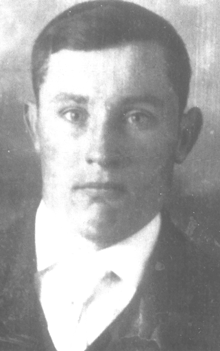
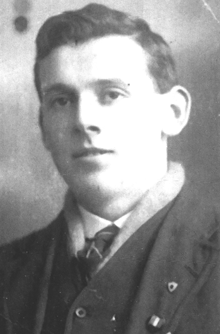
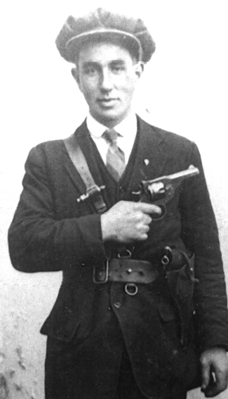
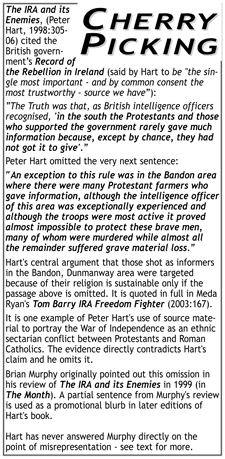
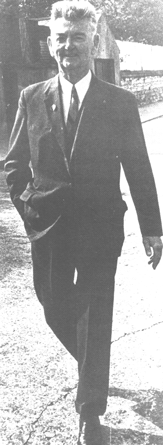
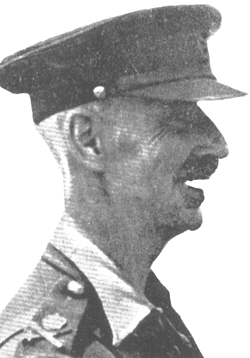
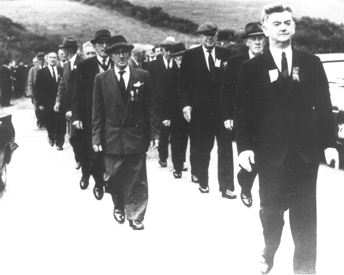
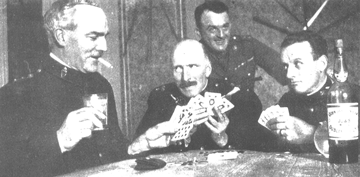
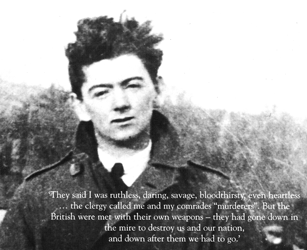
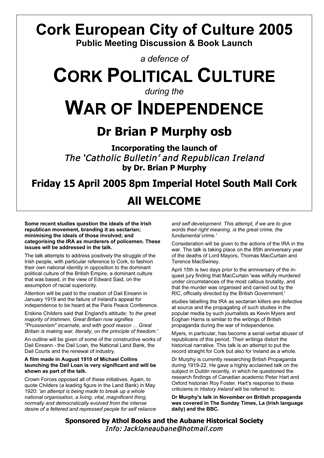
 printable version
printable version

 Digg this
Digg this del.icio.us
del.icio.us Furl
Furl Reddit
Reddit Technorati
Technorati Facebook
Facebook Gab
Gab Twitter
Twitter
View Full Comment Text
save preference
Comments (16 of 16)